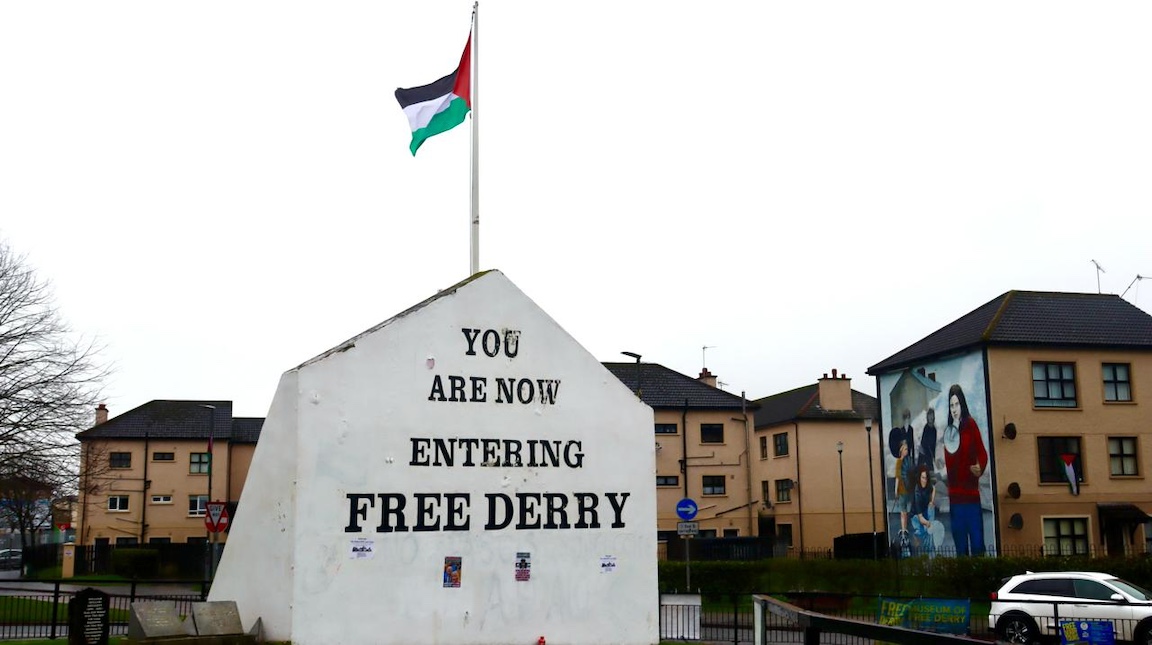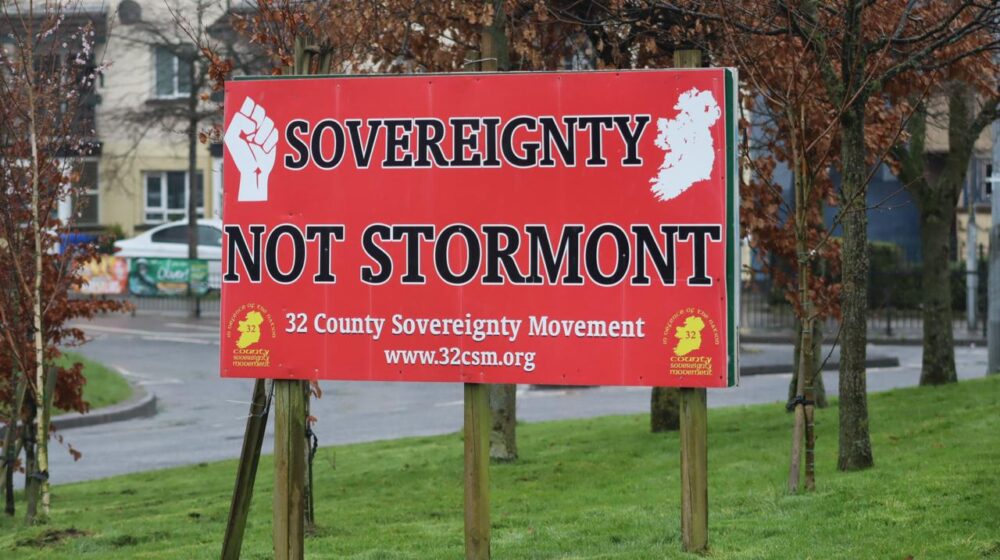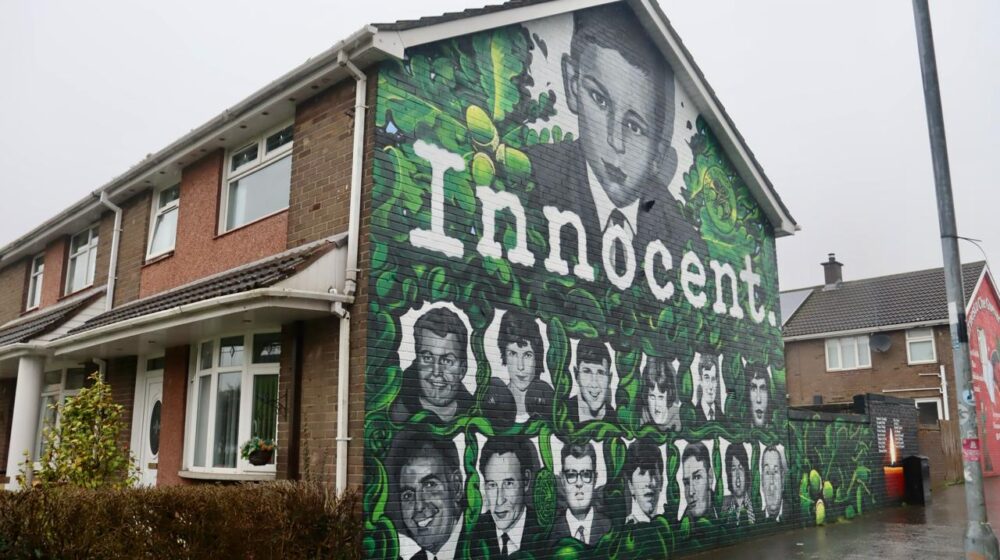
LONDONDERRY – Today, our class began exploring tumultuous divisiveness and violence in Londonderry’s recent history — and ended with an uplifting message of unity and friendship across religious divides.
After breakfast at the Maldron Hotel, we followed Northern Ireland guide, Dr. Barbara McDade, into the Bogside to learn more about the somber echoes of past conflict and the resilience of its people.
Our first stop of the day was The Museum of Free Derry. Walking down a slope into the Bogside neighborhood, we immediately noticed political posters and slogans in every direction. The streets were filled with flags from nations with which locals identify, including Palestine, Basque, Catalonia and Bosnia. Murals paid tribute to the innocent lives lost during Bloody Sunday when British soldiers shot 26 unarmed civilians during a protest march in the Bogside. There were also posters opposing the Good Friday Agreement and supporting the 32 County Sovereignty Movement, a political movement that is against the British rule of Northern Ireland.

McDade explained that members of the group ask “What are the 30 years of war if you still accept the control of the British over Northern Ireland?” in opposition to the Good Friday Agreement, which ended most of the conflicts of the Troubles, an ethno-nationalist conflict that segregated the population between Catholics and Protestants.
But the prospect of a united Ireland still seems distant, McDade explained. Despite nationalist sentiments, economic and trade opportunities and benefits like universal healthcare often dictate voting behavior.
After seeing the influence of the conflicts in the streets of the Bogside, we reached The Museum of Free Derry, which opened in 2007 to memorialize the events that occurred in the city known as ‘Free Derry’ from 1968 to 1972. This era encompasses the civil rights movement, the Battle of the Bogside, Internment, Bloody Sunday and Operation Motorman. Located in the middle of the Bloody Sunday conflict zone, it was right outside the museum that British officers wounded three men and killed two others.

The visit to the museum had a personal touch with the family history of the museum guide. Our guide, Eoin Yates, 30, wasn’t yet born on Bloody Sunday but has a personal connection — his great uncle, Patrick O’Donnell, was wounded after throwing himself across a woman to shield her from gunfire.
Yates explained other tactics employed by the authorities during the conflict, such as adding glass to rubber bullets to maximize harm. He described the contemporary relevance of these historical events, showing the parallels of modern instances of injustice. “‘Bloody Sunday’ is something that happens around the world,” he said.
Yates also shared that many visitors, particularly those from Britain, don’t know about the events that led to Bloody Sunday until they visit the museum.
In the years following the atrocities, the struggle for justice and recognition of Bloody Sunday continues. Yates discussed the ongoing legal proceedings against Soldier F, a former British soldier on trial for two murders and five attempted murders. Yates also criticized recent legislative efforts that seem to undermine the quest for accountability.
The Museum of Free Derry is not just a memorial, but also a means of engaging with global patterns of state aggression. Yates believes in the power of shared experiences to foster understanding and solidarity. “If we can use that experience to help others, then that’s what we have to do,” he said.
After the museum, our class dispersed for several hours of reporting time.
Ellie Davis, Katelin Moody and Emma Paidra visited Oakgrove Integrated College to learn more about integrated schools in Northern Ireland, which attempt to bring together children from both sides of the primary religious divide in Northern Ireland — Catholics and Protestants. They explored why the schools are still such a small segment compared to maintained (Catholic) and controlled (Protestant) schools.
Indy Scholtens interviewed Susan Gibson of Derry Well Woman about the Legacy Act. They talked about Gibson growing up in Derry during the Troubles. She founded Derry Well Woman because she believes that women suffer most often from conflicts yet don’t receive any special care.
Refael Kubersky, meanwhile, traveled back to Dublin to report at a mosque — he will meet up with our group in Belfast tomorrow.
As we mentioned before, stay tuned to read these pieces in the coming weeks.
Later, at 6:00 p.m., we gathered for dinner, joined by guests Bishop Andrew Forester from the Church of Ireland, Bishop Donal McKeown of the Catholic Church, Rev. Gordy McCracken from the Presbyterian Church, and Rev. Stephen Skuce of the Methodist Church. Surrounded by green and gold banners in preparation for St. Patrick’s Day, we learned about their journeys to faith and their initial interactions with Christians from other denominations. Overall, there was a shared optimism regarding the efforts of various churches to foster peace in Northern Ireland.
Edited by Trisha Mukherjee
